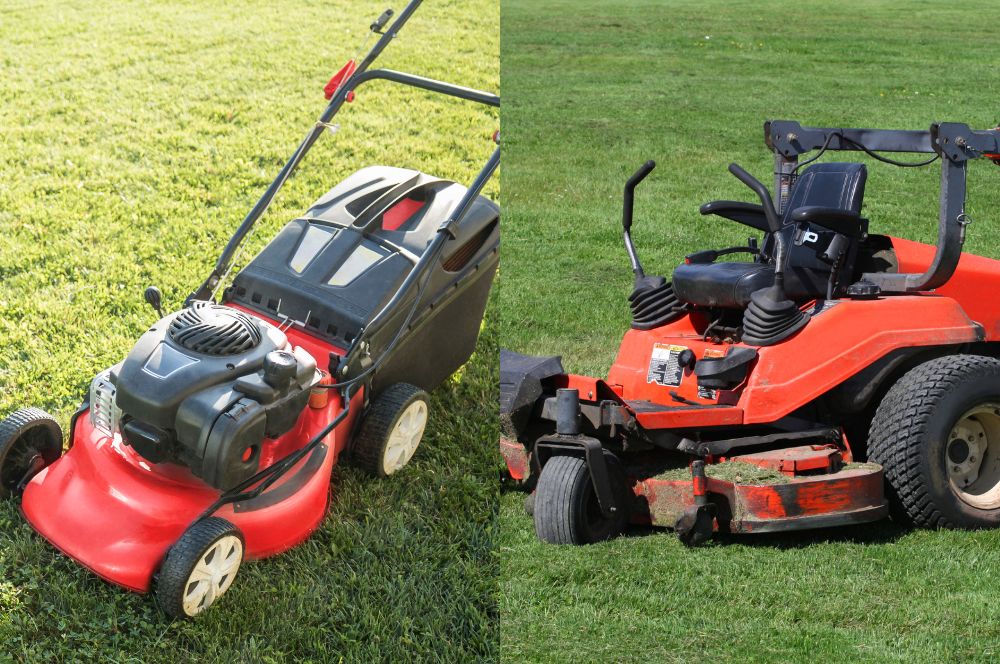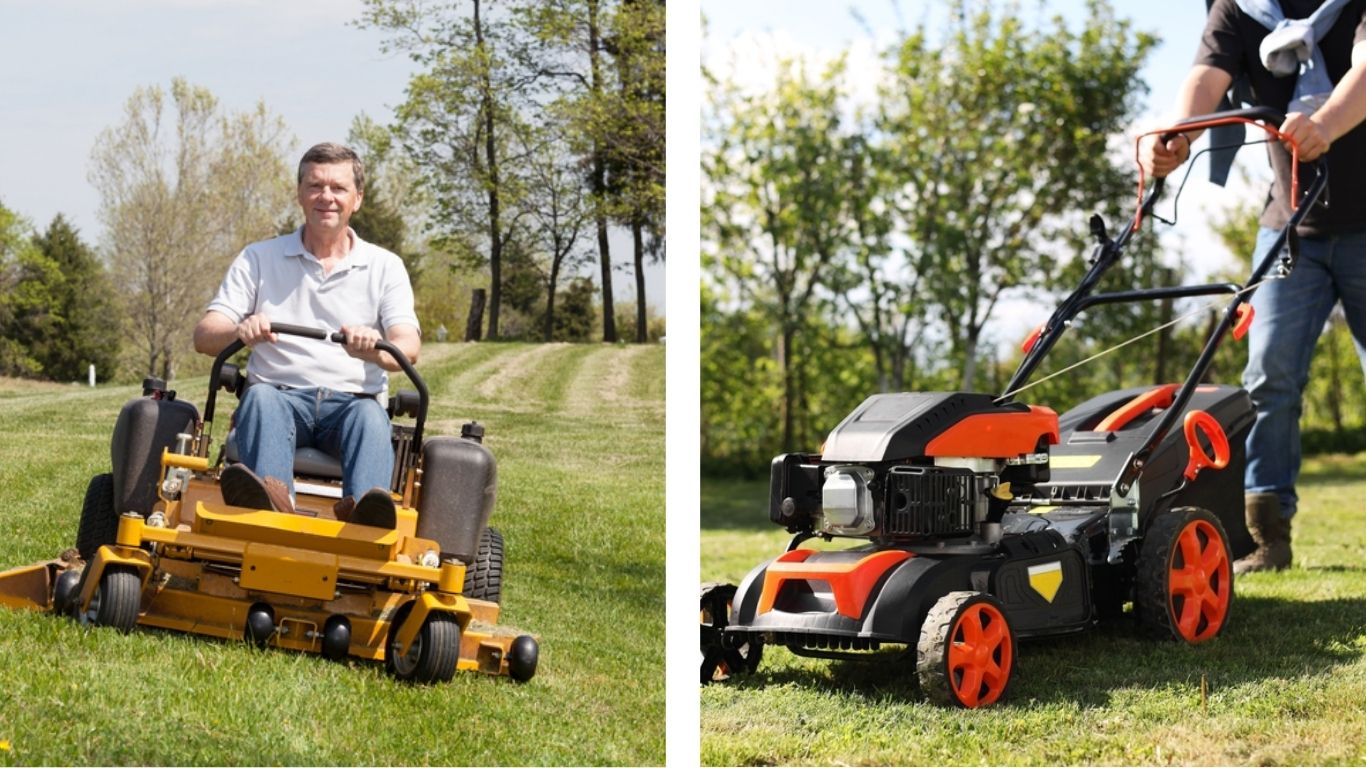When it comes to maintaining expansive lawns or tackling commercial landscaping projects, the walk behind vs zero turn mower debate is crucial for both efficiency and results. These two titans of turf management each bring unique strengths to the table, making the walk behind vs zero turn decision a pivotal one for professional landscapers and dedicated homeowners alike. At Best Lawn Mower For Hills, we’ve seen firsthand how this choice can make or break a lawn care operation.
Walk behind mowers offer precision and maneuverability, ideal for intricate landscapes, while zero turn models boast speed and coverage, perfect for vast open spaces. As we delve into the walk behind vs zero turn comparison, you’ll discover how factors like yard size, terrain complexity, and budget constraints play key roles in determining the best fit for your green endeavors. Let’s cut through the confusion and get to the root of what sets these mower types apart.
Understanding Walk Behind Mowers
Walk behind mowers, a staple in lawn care, offer unique advantages in the walk behind vs zero turn debate. These machines cater to specific needs and terrains, making them a preferred choice for many.
Key Features
Walk behind mowers excel in tight spaces. Their design allows for precise control, ideal for lawns with numerous obstacles or intricate landscaping. Cost-wise, they’re generally more budget-friendly than their zero turn counterparts, appealing to homeowners and small-scale landscapers.

Pros and Cons
Advantages:
- Superior maneuverability in complex layouts
- Lower initial investment
- Easier storage due to compact size
Drawbacks:
- Slower mowing speed on large, open areas
- Potential for operator fatigue on extensive lawns
- Limited cutting width compared to zero turn models
Exploring Zero Turn Mowers
Zero turn mowers stand out for their efficiency on larger lawns. These mowers have revolutionized commercial landscaping and are gaining popularity among homeowners with expansive properties.

Key Features
- Speed and Efficiency: Zero turn mowers boast impressive speed, covering vast areas quickly. Their unique steering system allows for 180-degree turns on the spot, minimizing time spent on each mowing session.
- Cutting Width: With wider decks than most walk behind models, zero turn mowers tackle broader swaths of grass in a single pass. This feature significantly reduces mowing time on open landscapes.
Pros and Cons
Advantages:
- Rapid mowing of large, open areas
- Exceptional maneuverability around obstacles
- Comfortable ride-on design for extended use
Drawbacks:
- Higher initial cost compared to walk behind models
- A steeper learning curve for operation
- Less effective on steep slopes or wet terrain
Comparing Walk Behind and Zero Turn Mowers
Understanding these several key factors helps in selecting the ideal mower for specific lawn care needs.

Performance Factors
- Mowing Efficiency: Walk behind mowers excel in precision, making them ideal for intricate landscapes. Zero turn models, however, dominate in speed, covering vast areas swiftly.
- Terrain Adaptability: Walk behind mowers handle varied terrains well, including slopes. Zero turn machines shine on flat, open spaces but may struggle on hillsides.
Cost Analysis
- Initial Investment: Walk behind mowers typically come with a lower price tag, appealing to budget-conscious buyers. Zero turn models command higher upfront costs but offer long-term efficiency gains.
- Operational Expenses: Fuel consumption varies, with zero turn mowers often using more fuel due to their power. Maintenance costs can be higher for zero turn models due to their complexity.
Maintenance Requirements
- Routine Upkeep: Both types need regular care, but zero turn mowers often require more frequent attention due to their sophisticated systems.
- Longevity and Repairs: Walk behind mowers, with their simpler design, often boast easier repairs. Zero turn models may need specialized maintenance, potentially increasing long-term costs.

Choosing the Right Mower for Your Needs
Selecting between walk behind vs zero turn mowers requires careful consideration of your specific lawn care requirements. This decision impacts both the efficiency and quality of results.
Factors to Consider
- Lawn Size and Layout: Walk-behind mowers offer precision for smaller yards with obstacles. The speed of zero-turn models benefits expansive, open areas.
- Budget Constraints: Initial costs favor walk behind mowers, while zero turn machines may provide long-term savings for large-scale operations.
User Experience Level
Novices might find walk behind mowers more intuitive. Zero turn models require a learning curve but offer enhanced productivity for experienced users.
Residential vs. Commercial Use
- Home Lawns: Walk behind mowers suit most residential needs, especially for yards under an acre. Larger properties may justify a zero turn investment.
- Professional Landscaping: Commercial operations often lean towards zero turn mowers for their efficiency. However, walk behind models remain crucial for detailed work and challenging terrains.
Discover Your Ideal Mower at Best Lawn Mower For Hills
At Best Lawn Mower For Hills, we’re passionate about helping you find the perfect lawn care solution. Our extensive range of walk behind and zero turn mowers caters to every need, from compact residential lawns to expansive commercial properties. We don’t just sell mowers; we provide expertise. Our team of lawn care professionals offers personalized advice, helping you navigate the walk behind vs zero turn decision with confidence.
We pride ourselves on curating a selection of top-quality machines, each rigorously tested to ensure performance and durability. Whether you’re a homeowner looking to streamline your weekend chores or a landscaping professional seeking to boost efficiency, Best Lawn Mower For Hills is your trusted partner in achieving a perfectly manicured lawn. Visit our website today to explore our collection and find the mower that will transform your lawn care experience.
Conclusion
The walk behind vs zero turn mower debate ultimately boils down to your specific needs and circumstances. At Best Lawn Mower For Hills, we’ve seen how both types excel in different scenarios. Walk behind mowers offer precision and maneuverability, ideal for smaller or intricate lawns. Zero turn models shine in efficiency and speed, perfect for large, open spaces. Consider your lawn size, terrain complexity, budget, and personal comfort when making your decision. Remember, the best mower is one that not only meets your current needs but also adapts to your future lawn care goals. Whether you opt for the hands-on approach of a walk behind or the swift efficiency of a zero turn, choosing the right mower will transform your lawn care experience from a chore into a satisfying task.
FAQs:
These insights will help you make an informed decision based on your specific lawn care needs.
Which mower is best for hilly terrain?
Walk behind mowers generally perform better on slopes. Their design provides better traction and stability on inclines. Zero turn mowers, while efficient on flat ground, may struggle on steep hills due to their wheel configuration.
Are zero turn mowers worth the extra cost?
For large, open areas, zero turn mowers can justify their higher price tag through time savings and increased productivity. However, for smaller lawns or complex landscapes, the cost-benefit ratio may favor walk behind models.
Can zero turn mowers create stripe patterns?
Yes, many zero turn mowers can create attractive stripe patterns. Some models come equipped with striping kits, while others can achieve this effect with proper mowing techniques and aftermarket accessories.
Which type requires more maintenance?
Zero turn mowers typically need more frequent maintenance due to their complex systems. Walk behind mowers, with their simpler design, often have lower maintenance requirements and costs.


